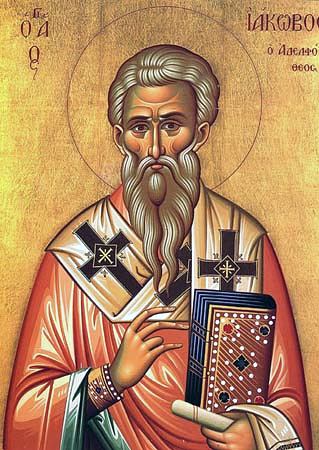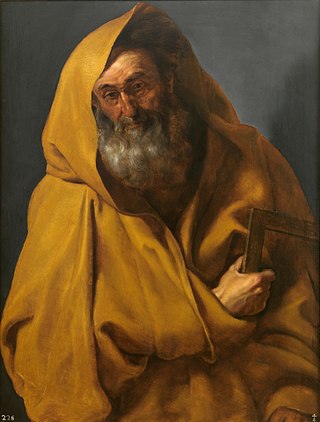
James the Less is a figure of early Christianity. He is also called "the Minor", "the Little", "the Lesser", or "the Younger", according to translation, in order to differentiate him from James the Great. James the Less has traditionally been commemorated along with St. Philip in the Western Christian calendars. In the Roman Catholic Church their feast day was observed on 1 May until 1955, when it was moved to 11 May to accommodate the Feast of St Joseph the Worker on 1 May. A later revision of the calendar moved the feast back to 3 May. In many other churches the feast has never moved from 1 May.

James the Just, or a variation of James, brother of the Lord, was a brother of Jesus, according to the New Testament. He was the first leader of the Jerusalem Church of the Apostolic Age. Traditionally, it is believed he was martyred in AD 62 or 69 by being stoned to death by the Pharisees on order of High Priest Ananus ben Ananus. James, Joses, Simon, and Judas are mentioned as the brothers or siblings of Jesus as well as two or more unnamed sisters.

The brothers of Jesus or the adelphoi are named in the New Testament as James, Joses, Simon, Jude, and unnamed sisters are mentioned in Mark and Matthew. They may have been: (1) the sons of Mary, the mother of Jesus, and Joseph, (2) sons of Mary the wife of Cleophas and sister of Mary, the mother of Jesus; or (3) sons of Joseph by a former marriage. While option 1 is described as the "most natural inference" from the New Testament, those who uphold the perpetual virginity of Mary reject the idea of biological brethren and maintain that the brothers and sisters were either cousins of Jesus or children of Joseph from a previous marriage. The Lutheran Churches have accepted both option 2 and option 3 as being valid explanations for the doctrine of the perpetual virginity of Mary.
Joses is a name, usually regarded as a form of Joseph, occurring many times in the New Testament:

In Christianity, a disciple is a dedicated follower of Jesus. This term is found in the New Testament only in the Gospels and Acts. In the ancient world, a disciple is a follower or adherent of a teacher. Discipleship is not the same as being a student in the modern sense. A disciple in the ancient biblical world actively imitated both the life and teaching of the master. It was a deliberate apprenticeship which made the fully formed disciple a living copy of the master.

In the New Testament, Salome was a follower of Jesus who appears briefly in the canonical gospels and in apocryphal writings. She is named by Mark as present at the crucifixion and as one of the Myrrhbearers, the women who found Jesus's empty tomb. Interpretation has further identified her with other women who are mentioned but not named in the canonical gospels. In particular, she is often identified as the wife of Zebedee, the mother of James and John, two of the Twelve apostles. In medieval tradition Salome was counted as one of the Three Marys who were daughters of Saint Anne, so making her the sister or half-sister of Mary, mother of Jesus.

Jude was one of the Twelve Apostles of Jesus according to the New Testament. He is generally identified as Thaddeus and is also variously called Judas Thaddaeus, Jude Thaddaeus, Jude of James, or Lebbaeus. He is sometimes identified with Jude, the brother of Jesus, but is clearly distinguished from Judas Iscariot, the disciple who betrayed Jesus prior to his crucifixion. Catholic writer Michal Hunt suggests that Judas Thaddaeus became known as Jude after early translators of the New Testament from Greek into English sought to distinguish him from Judas Iscariot and subsequently abbreviated his forename. Most versions of the New Testament in languages other than English and French refer to Judas and Jude by the same name.
Clopas is a figure of early Christianity. The name appears in the New Testament, specifically in John 19:25:
Near the cross of Jesus stood his mother, his mother's sister, Mary the wife of Clopas, and Mary Magdalene.

Alphaeus is a man mentioned in the New Testament as the father of two of the Twelve Apostles: Matthew the Evangelist and James, son of Alphaeus.
In the Acts of the Apostles, Joseph Barsabbas was one of two candidates qualified to be chosen for the office of apostle after Judas Iscariot lost his apostleship when he betrayed Jesus and committed suicide. After the casting of lots he was not chosen, the lot instead favoring Matthias to be numbered with the remaining eleven apostles.

According to the Gospel of John, Mary of Clopas was one of the women present at the crucifixion of Jesus and bringing supplies for his funeral. The expression Mary of Clopas in the Greek text is ambiguous as to whether Mary was the daughter or wife of Clopas, but exegesis has commonly favoured the reading "wife of Clopas". Hegesippus identified Clopas as a brother of Joseph. In the latest official edition of the Roman Martyrology of the Catholic Church she is commemorated with Salome on April 24th..

Jude is one of the brothers of Jesus (Greek: ἀδελφοί, romanized: adelphoi, lit. 'brethren') according to the New Testament. He is traditionally identified as the author of the Epistle of Jude, a short epistle which is reckoned among the seven general epistles of the New Testament—placed after Paul's epistles and before the Book of Revelation—and considered canonical by Christians. Catholics and Eastern Orthodox Christians believe this Jude is the same person as Jude the Apostle; Catholics hold that Jude was a cousin, but not literally a brother of Jesus, while the Eastern Orthodox hold that Jude is St. Joseph’s son from a previous marriage.

James, son of Alphaeus was one of the Twelve Apostles of Jesus, appearing under this name in all three of the Synoptic Gospels' lists of the apostles. He is generally identified with James the Less and commonly known by that name in church tradition. He is also labelled "the Minor", "the Little", "the Lesser", or "the Younger", according to translation. He is distinct from James, son of Zebedee and in some interpretations also from James, brother of Jesus. He appears only four times in the New Testament, each time in a list of the twelve apostles.

Mary, mother of James is identified in the synoptic gospels as one of the women who went to Jesus' tomb after he was buried. Mark 16:1 and Luke 24:10 refer to "Mary the mother of James" as one of the Myrrhbearers, the women who went to the tomb of Jesus.

Simon is described in the New Testament as one of the brothers of Jesus.

The following outline is provided as an overview of and topical guide to Christianity:

In Christian theology and ecclesiology, the apostles, particularly the Twelve Apostles, were the primary disciples of Jesus according to the New Testament. During the life and ministry of Jesus in the 1st century AD, the apostles were his closest followers and became the primary teachers of the gospel message of Jesus. There is also an Eastern Christian tradition derived from the Gospel of Luke of there having been as many as seventy apostles during the time of Jesus' ministry.

The name Mary, appears 54 times in the New Testament, in 49 verses. It was the single most popular female name among Jews of the Roman province of Judaea at the time, borne by about one in four women, and most of the New Testament references to Mary provide only the barest identifying information. Scholars and traditions therefore differ as to how many distinct women these references represent and which of them refer to the same person.

The name James appears 42 times in the New Testament. James was a very common given name in the historical period and region of Jesus, but surnames were still very rare. It is therefore not always clear which person these names refer to, and whether some refer to the same person or distinct characters, which has led to confusion. Therefore, Christian authors and modern scholars have given these men names based on their known attributes. According to American theologian and scholar Donald Hagner (2012), there are at least 5, and possibly up to 7, different Jameses in the New Testament.














